What to do in Sydney on a rainy day? Catch Chinese-Australian artist Lindy Lee and her Moon in a Dew Drop exhibition art in Sydney at MCA til February 2021.
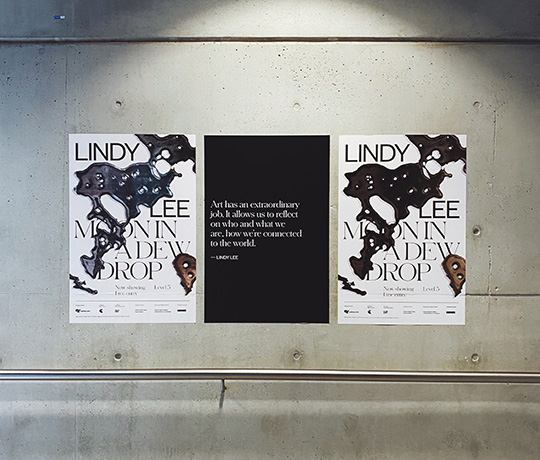
Moon In A Dew Drop at Sydney’s MCA is the most comprehensive presentation of the Lindy Lee’s practice to date. It brings together over 70 key works from the beginning of her career to the present, showcasing a range of paintings, sculptures, installations and public art.
I’m ashamed to say that I haven’t heard of Lee’s work until I saw this show advertised, and decided to explore her art in Sydney on a rainy Sunday.
What struck me first is the title of the show. Lee’s work incorporates her studies in zen buddhism. And this title is taken from a collection of writing by Zen philosopher, Digen, a 13th century Zen monk.
As the opening blurb in the exhibition explains, the moon represents the infinite and changing nature of the universe and time passing. The dew drop is an impermanent piece of phenomena in the natural world. This title invokes the idea that in this tiny dew drop reflecting the moon, the whole universe can be contained. In a world driven apart by he impact of the pandemic, populist policies and the people’s anguish reflected by the Hong Kong riots and #BLM movement, Lindy’s message is that everything – human and nature – is interconnected, and has never been more important.
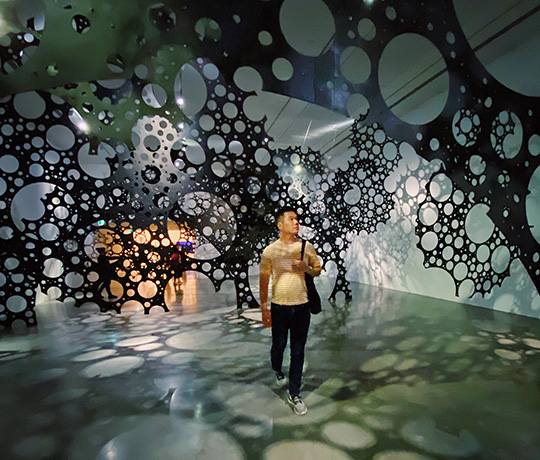
The exhibit of art in Sydney’s MCA displays key works from Lee’s extensive career from early photocopy artworks and wax paintings to recent large-scale installations and sculptures. I won’t go through every piece, but here are a few that spoke most strongly to me.
Virtue, Moral Order and the Discretion of Human Gesture, 1991
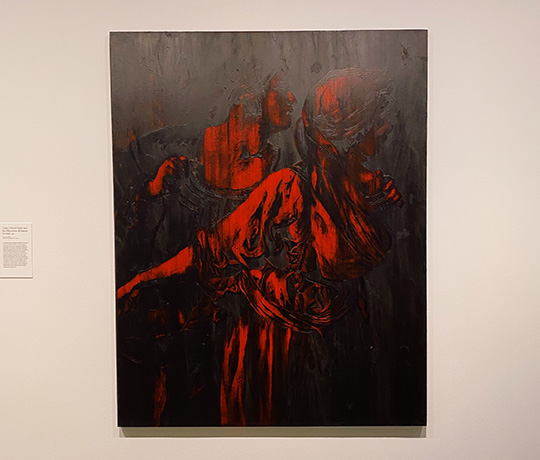
During her post-graduate studies doing art in Sydney at the College of the Arts, Indy began experimenting with a new technique to reproduce segments of the paintings. Scraping into layers of wax to reveal an image which nonetheless remains elusive. She describes it as a process of excavation, of “discovering” the image rather than trying to copy it. Thereby creating something new.
This piece is one of many in the collection, and was beautifully representative of her early work. This first room displayed much of Lindsay’s early pieces which were drawn to reproducing European classics and, combining with a personal touch, that would take on new meaning and become a new entity entity.
I loved this piece as the red wax revealed the forms underneath, but added a menacing layer that created a sense of unease and violence without ever needing to resort to showing something explicit or deliberately shocking.
The Dark, 1999
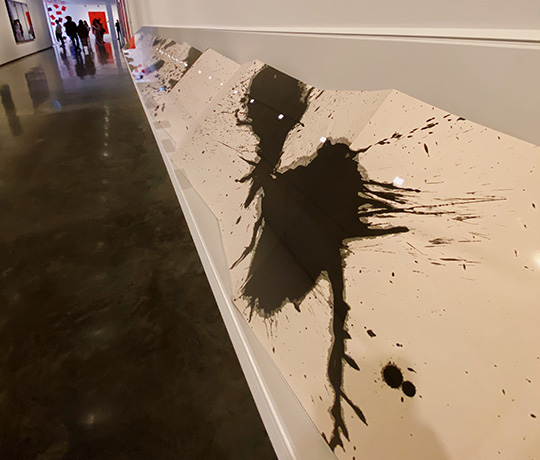
Following a conference about Asian art in Sydney, Lindy then decided to go to China to study the quintessentially Chinese art form of calligraphy. It is here that she discovered the practice of “flung ink” – mark-marking that is created by Buddhist monks after a period of meditation.
This concept of being caught between two worlds is a key theme of the exhibit and Lindy’s work as a whole. The motivation behind Lindy wanting to study in China is that she realised by turning to European artists for inspiration, she was ignoring, or even denying, her own cultural identity.
After reading about this in the description of the piece, I was caught off-guard. After emigrating to study in Australia, I was always told by those around me that “I sometimes forget you’re Asian”.
Back in the 90s, that was said as a bit of a complement. It meant that your English was better than expected. Your clothing was in line with western fashion. You understood Australian customs or slang… it was meant as a badge of honour that you’re not “fresh off the boat”.
And it wasn’t till I was much older did I realise that should have bothered me. That it DID bother me. In an effort to fit in in my new country, I had to hide – or even deny – my own heritage in order to “pass” and be accepted in this new one.
I’ve been carrying this denial well into my thirties. It wasn’t until recently have I begun to unlearn this ingrained imperialism and start to integrate my Chinese heritage into even simple things like my home cooking. Rediscovering the rich recipes, and extending that to the rich stories and world view of my heritage has actually helped me see that my unique blending of my two cultures. My two worlds is actually my superpower.
What struck me was that you can see in this one piece of work that same realisation. Moreover, you can see how this realisation went on to transform the rest of Lindy’s work and career.
Strange Condensations, 2020
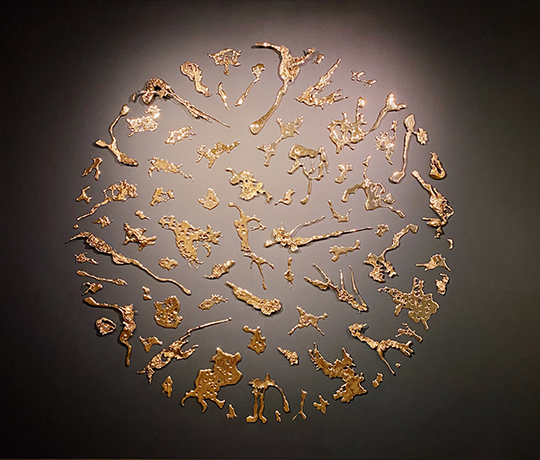
We jump ahead to her more recent works here, but the connection is clear between the flung ink with this new phase of flung bronze. As the artist describes it, bronze has to be heated to 1200 degree centigrade in order to become liquid. It’s elemental. The flung bronze is unpredictable and mysterious. “The reason the Chinese call it the calligraphy of the universe is because in that splash, it is understood that all conditions that subtend cosmos in this moment are alive in that splash. It absolutely embodies the totality of that instant.”
Listen to more of her interview on the MCA website here.
The Seamless Tomb
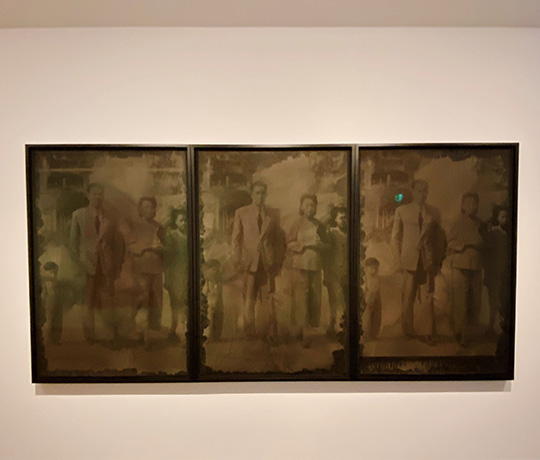
For me, the piece that spoke the most strongly wasn’t the immersive installations or the impressive giant bronze statues, but it was this key photographic work.
This image, printed and burnt, is of Lee’s mother, six months pregnant at the time, walking with her husband, his younger brother, her sister and their young son.
This picture was in fact taken moments before Lee’s father steps on the boat to come to Australia. To start a new life away from the grips of communism. Her mother doesn’t know when she will be seeing her husband again, and indeed it would be years before they would be reunited in Queensland due to the “White Australia” policy that did not allow immigrant workers to bring their families into the country.
This heartbreaking and immensely brave moment aside, the title of the image is also taken from a koan. A Koan is a Zen Buddhist story used in meditation.
It goes like this: Imagine you’re locked in a tomb that’s so tight, not even a sliver of light comes through. You will never go out. So, if you are stuck in this tomb, how can you ever be free?
Put another way, when you’re in moments of deep desperation and despair, like Lee’s mother no doubt felt at this moment, how do you find your way out?
Lindy Lee offers connection as salvation. When talking about this work (it’s well worth listening to the audio guide as you walk through), she offers: “When we begin to connect genuinely and be present to these things in our lives, we begin to see how interconnected everything is. So this seemingly seamless tomb, this tight, tight thing that we will never get out of suddenly becomes more expansive by the willingness to be with and to connect. And through that connection, the world becomes vast.”
A poignant message for 2020
A year that seems to offer seamless tombs within seamless tombs. Though the war-cry of “we are in this together” may seem like a glib hashtag of the new decade, it may in fact be rooted in the century-old wisdom of Zen Buddhism, and proven to give us both comfort and a way out of despair. Most of all, though our problems and feeling of despair is unique in circumstance to our times, despair itself is not. And so the solution to it needs not be novel.
Perhaps through the wisdom of generations past, there is hope and a way out for us yet.
Want to see Lindy Lee’s incredible artwork for yourself?
The Moon in a Dew Drop exhibition is held at the Museum of Contemporary art in Sydney until February 2021.





















